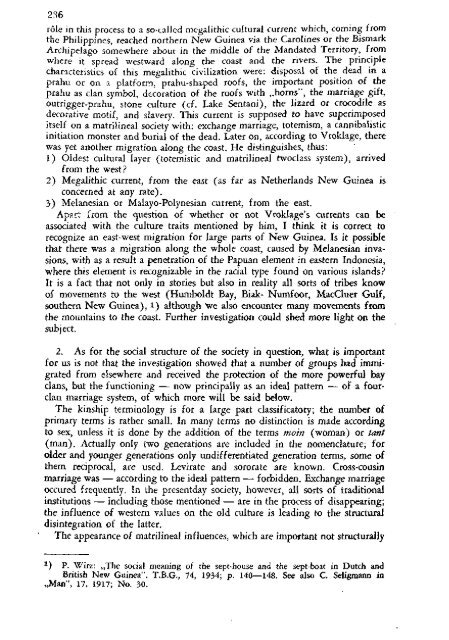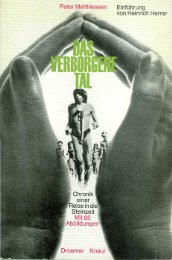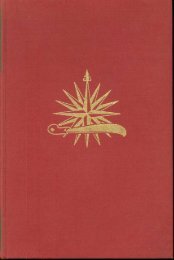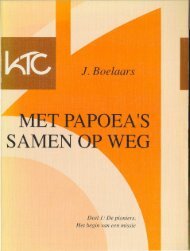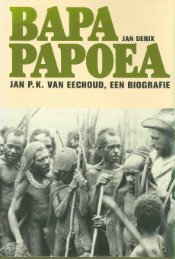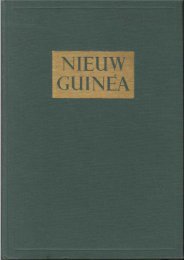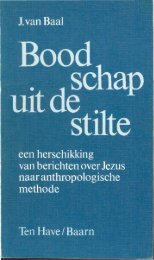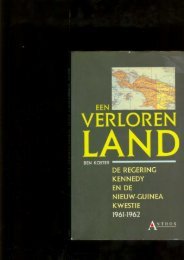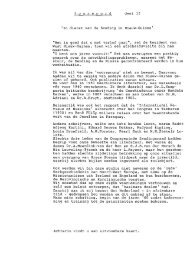Untitled - Stichting Papua Erfgoed
Untitled - Stichting Papua Erfgoed
Untitled - Stichting Papua Erfgoed
Create successful ePaper yourself
Turn your PDF publications into a flip-book with our unique Google optimized e-Paper software.
236<br />
rôle in this process to a so-called megalithic cultural current which, coming from<br />
the Philippines, reached northern New Guinea via the Carolines or the Bismark<br />
Archipelago somewhere about in the middle of the Mandated Territory, from<br />
where it spread westward along the coast and the rivers. The principle<br />
characteristics of this megalithic civilization were: disposal of the dead in a<br />
prahu or on a platform, prahu-shaped roofs, the important position of the<br />
prahu as clan symbol, decoration of the roofs with „horns", the marriage gift,<br />
outrigger-prahu, stone culture (cf. Lake Sentani), the lizard or crocodile as<br />
decorative motif, and slavery. This current is supposed to have superimposed<br />
itself on a matrilineal society with: exchange marriage, totemism, a cannibalistic<br />
initiation monster and burial of the dead. Later on, according to Vroklage, there<br />
was yet another migration along the coast. He distinguishes, thus:<br />
1) Oldest cultural layer (totemistic and matrilineal rwoclass system), arrived<br />
from the west?<br />
2) Megalithic current, from the east (as far as Netherlands New Guinea is<br />
concerned at any rate).<br />
3) Melanesian or Malayo-Polynesian current, from the east.<br />
Apart from the question of whether or not Vroklage's currents can be<br />
associated with the culture traits mentioned by him, I think it is correct to<br />
recognize an east-west migration for large parts of New Guinea. Is it possible<br />
that there was a migration along the whole coast, caused by Melanesian invasions,<br />
with as a result a penetration of the <strong>Papua</strong>n element in eastern Indonesia,<br />
where this element is recognizable in the racial type found on various islands?<br />
It is a fact that not only in stories but also in reality all sorts of tribes know<br />
of movements to the west (Humboldt Bay, Biak- Numfoor, MacCluer Gulf,<br />
southern New Guinea), 1 ) although we also encounter many movements from<br />
the mountains to the coast. Further investigation could shed more light on the<br />
subject.<br />
2. As for the social structure of the society in question, what is important<br />
for us is not that the investigation showed that a number of groups had immigrated<br />
from elsewhere and received the protection of the more powerful bay<br />
clans, but the functioning — now principally as an ideal pattern — of a fourclan<br />
marriage system, of which more will be said below.<br />
The kinship terminology is for a large part classifcatory; the number of<br />
primary terms is rather small. In many terms no distinction is made according<br />
to sex, unless it is done by the addition of the terms moin (woman) or tant<br />
(man). Actually only two generations are included in the nomenclature; for<br />
older and younger generations only undifferentiated generation terms, some of<br />
them reciprocal, are used. Levirate and sororate are known. Cross-cousin<br />
marriage was — according to the ideal pattern — forbidden. Exchange marriage<br />
occured frequently. In the presentday society, however, all sorts of traditional<br />
institutions — including those mentioned — are in the process of disappearing;<br />
the influence of western values on the old culture is leading to the structural<br />
disintegration of the latter.<br />
The appearance of matrilineal influences, which are important not structurally<br />
1 ) P. Wirz: „The social meaning of the sept-house and the sept-boat in Dutch and<br />
British New Guinea". T.B.G., 14, 1934; p. 140—148. See also C. Seligmann in<br />
„Man", 17, 1917; No. 30.


